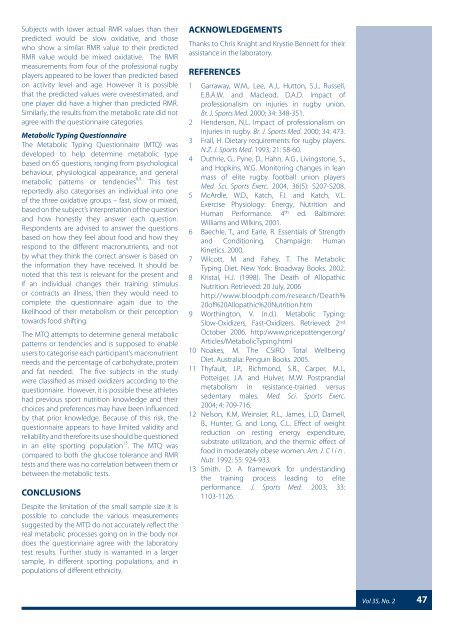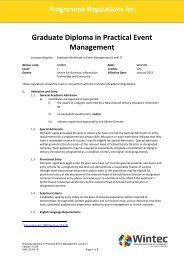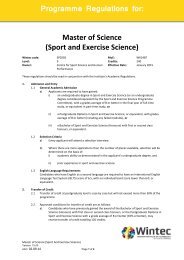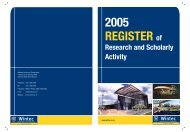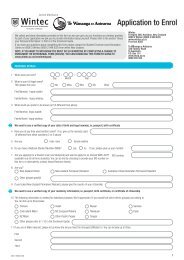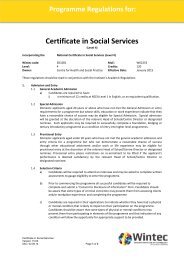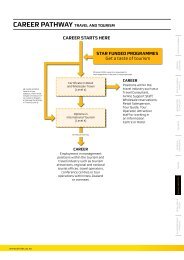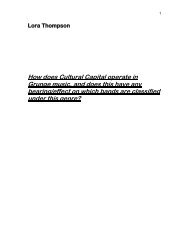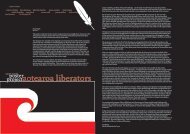Physiological analysis of the metabolic typing diet in professional ...
Physiological analysis of the metabolic typing diet in professional ...
Physiological analysis of the metabolic typing diet in professional ...
Create successful ePaper yourself
Turn your PDF publications into a flip-book with our unique Google optimized e-Paper software.
Subjects with lower actual RMR values than <strong>the</strong>ir<br />
predicted would be slow oxidative, and those<br />
who show a similar RMR value to <strong>the</strong>ir predicted<br />
RMR value would be mixed oxidative. The RMR<br />
measurements from four <strong>of</strong> <strong>the</strong> pr<strong>of</strong>essional rugby<br />
players appeared to be lower than predicted based<br />
on activity level and age. However it is possible<br />
that <strong>the</strong> predicted values were overestimated, and<br />
one player did have a higher than predicted RMR.<br />
Similarly, <strong>the</strong> results from <strong>the</strong> <strong>metabolic</strong> rate did not<br />
agree with <strong>the</strong> questionnaire categories.<br />
Metabolic Typ<strong>in</strong>g Questionnaire<br />
The Metabolic Typ<strong>in</strong>g Questionnaire (MTQ) was<br />
developed to help determ<strong>in</strong>e <strong>metabolic</strong> type<br />
based on 65 questions, rang<strong>in</strong>g from psychological<br />
behaviour, physiological appearance, and general<br />
<strong>metabolic</strong> patterns or tendencies 8,9 . This test<br />
reportedly also categorises an <strong>in</strong>dividual <strong>in</strong>to one<br />
<strong>of</strong> <strong>the</strong> three oxidative groups – fast, slow or mixed,<br />
based on <strong>the</strong> subject’s <strong>in</strong>terpretation <strong>of</strong> <strong>the</strong> question<br />
and how honestly <strong>the</strong>y answer each question.<br />
Respondents are advised to answer <strong>the</strong> questions<br />
based on how <strong>the</strong>y feel about food and how <strong>the</strong>y<br />
respond to <strong>the</strong> different macronutrients, and not<br />
by what <strong>the</strong>y th<strong>in</strong>k <strong>the</strong> correct answer is based on<br />
<strong>the</strong> <strong>in</strong>formation <strong>the</strong>y have received. It should be<br />
noted that this test is relevant for <strong>the</strong> present and<br />
if an <strong>in</strong>dividual changes <strong>the</strong>ir tra<strong>in</strong><strong>in</strong>g stimulus<br />
or contracts an illness, <strong>the</strong>n <strong>the</strong>y would need to<br />
complete <strong>the</strong> questionnaire aga<strong>in</strong> due to <strong>the</strong><br />
likelihood <strong>of</strong> <strong>the</strong>ir metabolism or <strong>the</strong>ir perception<br />
towards food shift<strong>in</strong>g.<br />
The MTQ attempts to determ<strong>in</strong>e general <strong>metabolic</strong><br />
patterns or tendencies and is supposed to enable<br />
users to categorise each participant’s macronutrient<br />
needs and <strong>the</strong> percentage <strong>of</strong> carbohydrate, prote<strong>in</strong><br />
and fat needed. The five subjects <strong>in</strong> <strong>the</strong> study<br />
were classified as mixed oxidizers accord<strong>in</strong>g to <strong>the</strong><br />
questionnaire. However, it is possible <strong>the</strong>se athletes<br />
had previous sport nutrition knowledge and <strong>the</strong>ir<br />
choices and preferences may have been <strong>in</strong>fluenced<br />
by that prior knowledge. Because <strong>of</strong> this risk, <strong>the</strong><br />
questionnaire appears to have limited validity and<br />
reliability and <strong>the</strong>refore its use should be questioned<br />
<strong>in</strong> an elite sport<strong>in</strong>g population 13 . The MTQ was<br />
compared to both <strong>the</strong> glucose tolerance and RMR<br />
tests and <strong>the</strong>re was no correlation between <strong>the</strong>m or<br />
between <strong>the</strong> <strong>metabolic</strong> tests.<br />
CONCLUSIONS<br />
Despite <strong>the</strong> limitation <strong>of</strong> <strong>the</strong> small sample size it is<br />
possible to conclude <strong>the</strong> various measurements<br />
suggested by <strong>the</strong> MTD do not accurately reflect <strong>the</strong><br />
real <strong>metabolic</strong> processes go<strong>in</strong>g on <strong>in</strong> <strong>the</strong> body nor<br />
does <strong>the</strong> questionnaire agree with <strong>the</strong> laboratory<br />
test results. Fur<strong>the</strong>r study is warranted <strong>in</strong> a larger<br />
sample, <strong>in</strong> different sport<strong>in</strong>g populations, and <strong>in</strong><br />
populations <strong>of</strong> different ethnicity.<br />
ACKNOWLEDGEMENTS<br />
Thanks to Chris Knight and Krystie Bennett for <strong>the</strong>ir<br />
assistance <strong>in</strong> <strong>the</strong> laboratory.<br />
REFERENCES<br />
1 Garraway, W.M., Lee, A.J., Hutton, S.J., Russell,<br />
E.B.A.W. and Macleod, D.A.D. Impact <strong>of</strong><br />
pr<strong>of</strong>essionalism on <strong>in</strong>juries <strong>in</strong> rugby union.<br />
Br. J. Sports Med. 2000; 34: 348-351.<br />
2 Henderson, N.L. Impact <strong>of</strong> pr<strong>of</strong>essionalism on<br />
<strong>in</strong>juries <strong>in</strong> rugby. Br. J. Sports Med. 2000; 34: 473.<br />
3 Frail, H. Dietary requirements for rugby players.<br />
N.Z. J. Sports Med. 1993; 21: 58-60.<br />
4 Duthrie, G., Pyne, D., Hahn, A.G., Liv<strong>in</strong>gstone, S.,<br />
and Hopk<strong>in</strong>s, W.G. Monitor<strong>in</strong>g changes <strong>in</strong> lean<br />
mass <strong>of</strong> elite rugby football union players<br />
Med. Sci. Sports Exerc. 2004, 36(5): S207-S208.<br />
5 McArdle, W.D., Katch, F.I. and Katch, V.L.<br />
Exercise Physiology: Energy, Nutrition and<br />
Human Performance. 4 th ed. Baltimore:<br />
Williams and Wilk<strong>in</strong>s, 2001.<br />
6 Baechle, T., and Earle, R. Essentials <strong>of</strong> Strength<br />
and Condition<strong>in</strong>g. Champaign: Human<br />
K<strong>in</strong>etics. 2000.<br />
7 Wilcott, M and Fahey, T. The Metabolic<br />
Typ<strong>in</strong>g Diet. New York: Broadway Books. 2002.<br />
8 Kristal, H.J. (1998). The Death <strong>of</strong> Allopathic<br />
Nutrition. Retrieved: 20 July, 2006<br />
http://www.bloodph.com/research/Death%<br />
20<strong>of</strong>%20Allopathic%20Nutrition.htm<br />
9 Worth<strong>in</strong>gton, V. (n.d.). Metabolic Typ<strong>in</strong>g:<br />
Slow-Oxidizers, Fast-Oxidizers. Retrieved: 2 nd<br />
October 2006. http:/www.pricepottenger.org/<br />
Articles/MetabolicTyp<strong>in</strong>g.html<br />
10 Noakes, M. The CSIRO Total Wellbe<strong>in</strong>g<br />
Diet. Australia: Pengu<strong>in</strong> Books. 2005.<br />
11 Thyfault, J.P., Richmond, S.R., Carper, M.J.,<br />
Potteiger, J.A. and Hulver, M.W. Postprandial<br />
metabolism <strong>in</strong> resistance-tra<strong>in</strong>ed versus<br />
sedentary males. Med. Sci. Sports Exerc.<br />
2004; 4: 709-716.<br />
12 Nelson, K.M, We<strong>in</strong>sier, R.L., James, L.D, Darnell,<br />
B., Hunter, G. and Long, C.L. Effect <strong>of</strong> weight<br />
reduction on rest<strong>in</strong>g energy expenditure,<br />
substrate utilization, and <strong>the</strong> <strong>the</strong>rmic effect <strong>of</strong><br />
food <strong>in</strong> moderately obese women. Am. J. C l i n .<br />
Nutr. 1992; 55: 924-933.<br />
13 Smith, D. A framework for understand<strong>in</strong>g<br />
<strong>the</strong> tra<strong>in</strong><strong>in</strong>g process lead<strong>in</strong>g to elite<br />
performance. J. Sports Med. 2003; 33:<br />
1103-1126.<br />
Vol 35, No. 2<br />
47


